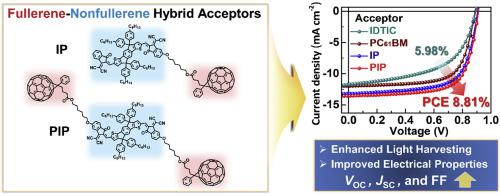Materials Today Energy ( IF 9.3 ) Pub Date : 2021-01-20 , DOI: 10.1016/j.mtener.2021.100651 Ziang Wu , Seungjin Lee , Sang Young Jeong , Min Hun Jee , Hyun Gyeong Lee , Chulhee Lim , Cheng Wang , Bumjoon J. Kim , Han Young Woo

|
Two fullerene–non-fullerene hybrid acceptors, IDTIC-PC61BM (IP) and PC61BM-IDTIC-PC61BM (PIP), are synthesized by combining a non-fullerene acceptor, 3,9-bis(2-methylene-(3-(1,1-dicyanomethylene)-indanone))-5,5,11,11-tetrakis(4-hexylphenyl)-dithieno[2,3-d:2′,3′-d’]-s-indaceno[1,2-b:5,6-b’]dithiophene (IDTIC), and a fullerene derivative, phenyl-C61-butyric acid methyl ester (PC61BM). To evaluate the potential of these hybrid acceptors, we fabricate organic solar cells (OSCs) based on the four different acceptors (i.e. IP, PIP, IDTIC, and PC61BM) and the same polymer donor (PBDB-T). In IP and PIP, the IDTIC moiety compensates for the poor light absorption of PC61BM in the visible wavelength region, improving the short-circuit current density (JSC) of the hybrid acceptor-based OSCs (11.9 → 13.1 mA cm−2). Meanwhile, the charge transport and recombination properties of the PBDB-T:IDTIC devices improve significantly after the substitution of IDTIC with IP or PIP, leading to a significant increase in the fill factor (0.54 → 0.68) as well as JSC (11.8 → 13.1 mA cm−2) of the devices. Therefore, owing to the synergistic effect of the broad light absorption of IDTIC and efficient electron transport of PC61BM, the hybrid acceptor-based OSCs show significantly higher power conversion efficiencies of 8.81% (PBDB-T:PIP) and 8.17% (PBDB-T:IP) than the PBDB-T:PC61BM (7.62%) and PBDB-T:IDTIC (5.98%) OSCs. The results demonstrate the effectiveness of the hybrid acceptor design in overcoming the shortcomings of individual acceptors and improving their photovoltaic performance.
中文翻译:

富勒烯-非富勒烯杂化受体可增强有机太阳能电池的光吸收和电性能
通过结合非富勒烯受体3,9-双(2-亚甲基)合成两个富勒烯-非富勒烯杂化受体IDTIC-PC 61 BM(IP)和PC 61 BM-IDTIC-PC 61 BM(PIP)。 -(3-(1,1-二氰基亚甲基)-茚满酮))-5,5,11,11-四(4-己基苯基)-二硫代[2,3-d:2',3'-d']-s -茚并[1,2-b:5,6-b']二噻吩(IDTIC)和富勒烯衍生物苯基-C 61-丁酸甲酯(PC 61 BM)。为了评估这些混合受体的潜力,我们基于四种不同的受体(即IP,PIP,IDTIC和PC 61 BM)和相同的聚合物供体(PBDB-T)制造了有机太阳能电池(OSC )。在IP和PIP中,IDTIC部分可补偿PC 61不良的光吸收BM在可见光波长范围内,提高了基于混合受体的OSC(11.9→13.1 mA cm -2)的短路电流密度(J SC)。同时,用IP或PIP代替IDTIC后,PBDB-T:IDTIC器件的电荷传输和重组特性显着提高,导致填充因子(0.54→0.68)和J SC(11.8→器件的13.1 mA cm -2)。因此,由于IDTIC广泛吸收光和PC 61的有效电子传输的协同作用BM(基于混合受体的OSC)显示出比PBDB-T:PC 61 BM(7.62%)和PBDB-显着更高的功率转换效率,分别为8.81%(PBDB-T:PIP)和8.17%(PBDB-T:IP)。T:IDTIC(5.98%)OSC。结果证明了混合受体设计在克服单个受体的缺点和改善其光伏性能方面的有效性。


























 京公网安备 11010802027423号
京公网安备 11010802027423号